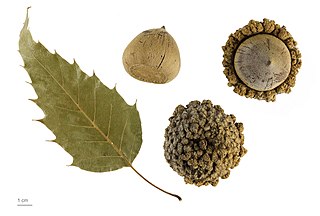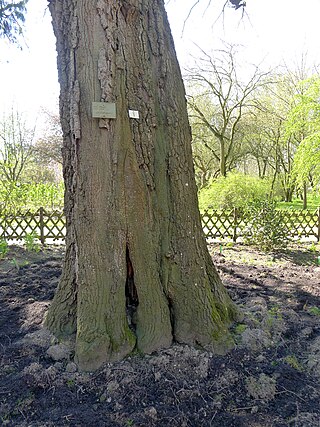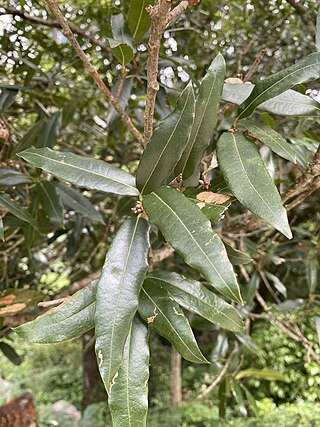
The Sierra Madre sparrow, also known as Bailey's sparrow, is an endangered, range-restricted, enigmatic American sparrow. It is endemic to Mexico and is threatened with extinction through habitat loss.
The yellowbelly voiceless tree frog is a species of frog in the family Hylidae endemic to Mexico.

Quercus acerifolia is a rare North American species of oak in the red oak section of Quercus. It is endemic to just four locations within the Ouachita Mountains of the State of Arkansas.
Quercus deliquescens is a species of oak tree in the family Fagaceae, native to northeast Mexico. It is placed in section Quercus.

Quercus devia is a species of oak tree in the family Fagaceae, native to northwestern Mexico. The tree is endemic to the Sierra de la Laguna range of the Peninsular Ranges system, located in the southern part of the Mexican state of Baja California Sur. It grows in Sierra de la Laguna pine-oak forests habitats. It is an IUCN Red List endangered species, threatened by habitat loss. It is placed in section Lobatae.
Quercus galeanensis is a species of oak tree in the family Fagaceae, native to Northeastern Mexico. The tree is endemic to Mexico, restricted to two subpopulations occupying a narrow band from Galeana in Nuevo León state, to the Miquihuana region in Tamaulipas state. It is an IUCN Red List endangered species, threatened by habitat loss. It is placed in section Lobatae.

Quercus germana, the Mexican royal oak, is a species of oak tree in the family Fagaceae. It is native to mountain cloud forests in eastern Mexico. It is placed in section Quercus.
Quercus macdougallii is a species of plant in the family Fagaceae. It is placed in section Quercus.

Quercus miquihuanensis is a species of oak in the family Fagaceae. It is endemic to the Nuevo León and Tamaulipas states of Mexico. It is an endangered species, threatened by habitat loss. It is placed in section Lobatae.

Quercus skinneri is a species of oak. It is found in Mexico, Guatemala, Honduras, and El Salvador. It is threatened by habitat loss.
Quercus vicentensis is a species of oak tree in the family Fagaceae, native to southern Mexico and northern Central America. It is placed in section Quercus.

Quercus alnifolia, commonly known as the golden oak, is an evergreen oak species of Cyprus. Its common English name refers to the golden coloured lower surface of its leaves. Quercus alnifolia belongs to the endemic flora of the island and it is confined to the igneous geological complex of the Troodos Mountains. In February 2006, the parliament of Cyprus selected the golden oak to be the country's national tree.

Quercus afares, the African oak, is a species of oak native to Algeria and Tunisia. It has a very limited distribution in the coastal mountains of the eastern Tell Atlas in Algeria, and the Mogod-Kroumerie region of northwestern Tunisia. Quercus afares is deciduous, with a corky bark, and can reach 25–30 metres in height. It grows in dense stands, associated with cork oak at elevations as low as 200 metres, and with the semi-deciduous Algerian oak (Q. canariensis) from 700 to 1600 metres elevation. Q. afares can also be found in monospecific stands, especially above 1200 metres on soils damaged by fire. It is endemic to the eastern coastal portion of the Mediterranean conifer and mixed forests ecoregion.
Quercus hinckleyi, commonly called Hinckley oak, is a rare species in the white oak group. It has a restricted range in the Chihuahuan Desert of the southwestern United States and northern Mexico. In the US, it occurs in only two counties in southwestern Texas and is federally listed as a threatened species.

Quercus paxtalensis is a species of oak endemic to Mexico.

Quercus pinnativenulosa is a species of oak endemic to Mexico.
Quercus flocculenta is an endangered species of oak in the family Fagaceae, native to northeastern Mexico. It is endemic to the Sierra Madre Oriental of Nuevo León state.
Quercus edwardsiae is a species of oak endemic to northeastern Mexico.
Quercus tuitensis is a species of oak. It is endemic to the Sierra el Tuito of Jalisco state in western Mexico.
Quercus kotschyana is a species of oak endemic to the mountains of Lebanon. It is placed in subgenus Quercus, section Quercus.










